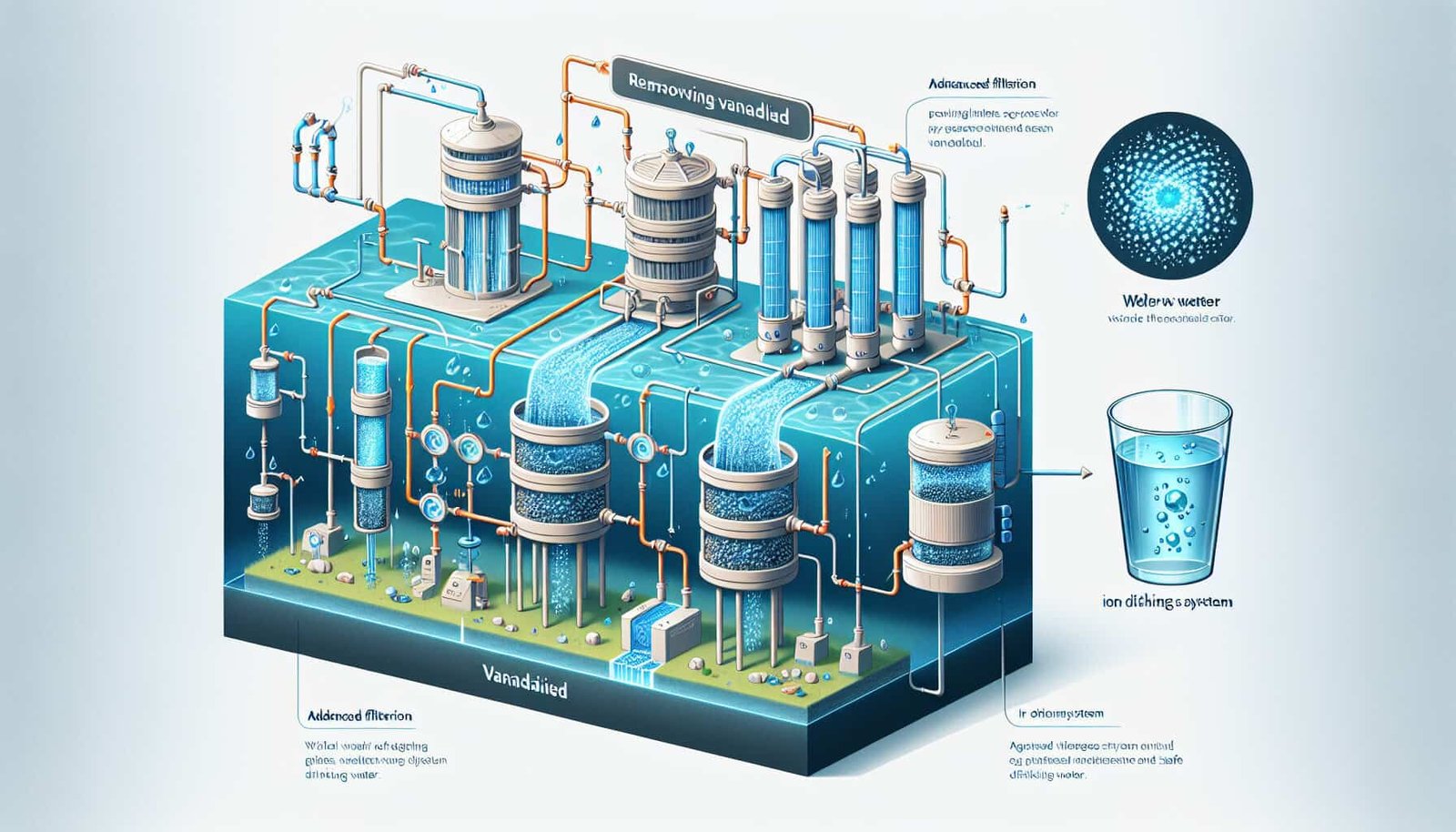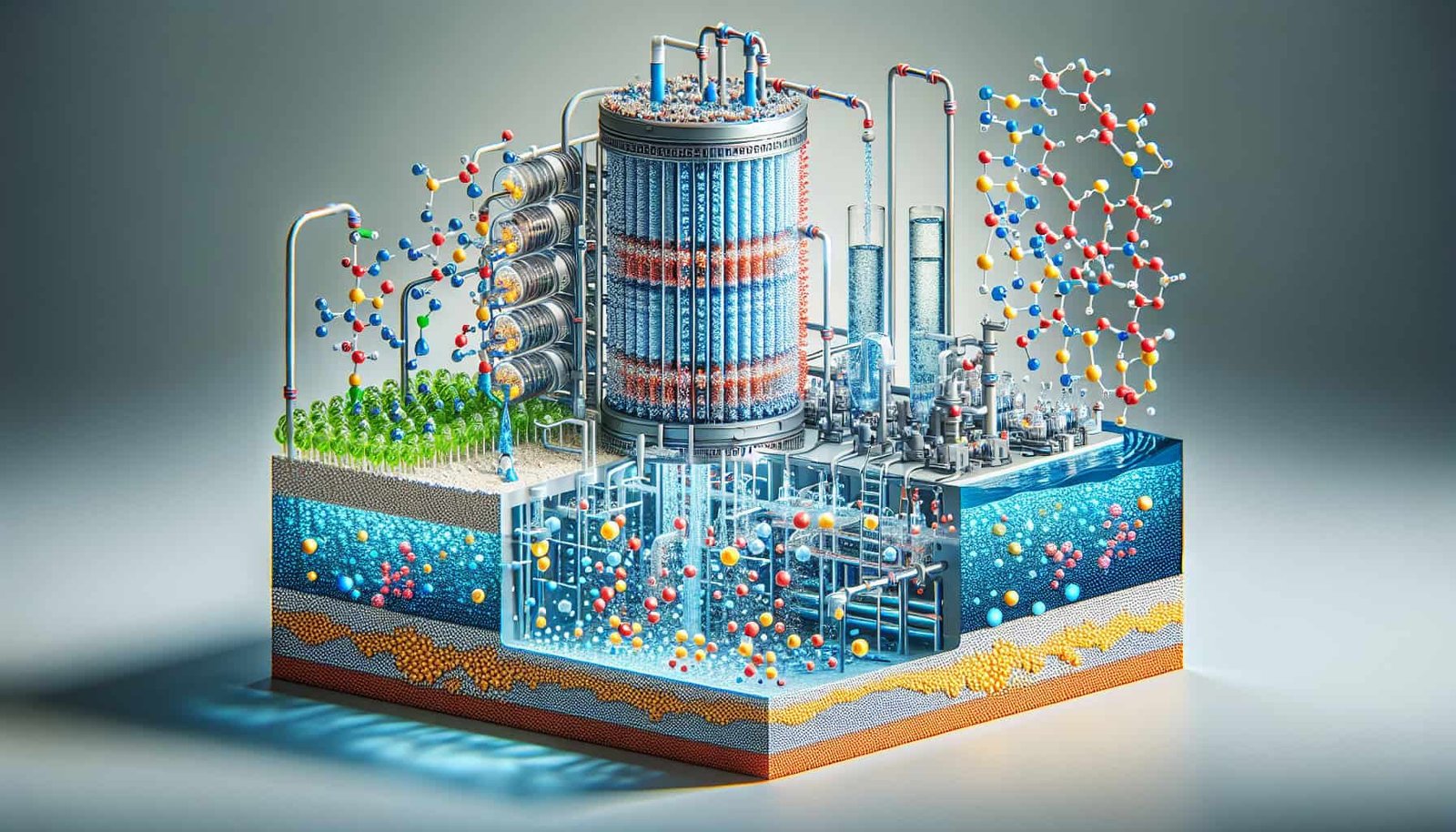Are you facing the challenge of high levels of vanadium in your well water? Don’t worry, because in this article, we will explore the various treatment options that are available to address this issue. Vanadium, a naturally occurring element, can often be found at elevated levels in well water. However, it is crucial to ensure its concentration remains within safe limits to avoid any harmful effects. So, let’s dive into the world of water treatment and discover how you can mitigate the presence of high vanadium levels in your well water.

Overview of Vanadium in Well Water
Vanadium contamination in well water is a growing concern that necessitates a thorough understanding of its potential health risks and the importance of treating it effectively. Vanadium, a naturally occurring element, can leach into groundwater from various sources such as mining and industrial activities. In this article, we will explore the different treatment options available for well water with high levels of vanadium, ensuring the safety and quality of your water supply.
Understanding Vanadium Contamination
To effectively treat vanadium in well water, it is crucial to understand how it becomes contaminated. Vanadium can enter groundwater through natural processes, but human activities significantly contribute to its contamination. Industries that use vanadium or release it as a byproduct can unintentionally contaminate water sources. Additionally, mining operations and the use of fossil fuels are major sources of vanadium contamination. By understanding the sources of vanadium in well water, we can better address the issue and choose the appropriate treatment methods.
Health Risks Associated with Vanadium
While vanadium is an essential trace element required by the human body in small amounts, high levels can have adverse health effects. Prolonged exposure to elevated vanadium concentrations through drinking water can lead to various health risks. These include respiratory problems, damage to the liver and kidneys, and potential developmental issues in children. To ensure the health and well-being of you and your family, it is crucial to treat well water contaminated with high levels of vanadium.
Importance of Treating Vanadium in Well Water
Treating vanadium in well water is vital for several reasons. Firstly, it ensures the safety of your water supply by reducing the potential health risks associated with vanadium contamination. Secondly, treatment helps maintain the quality of your water, ensuring its taste, odor, and appearance meet desirable standards. Lastly, addressing vanadium contamination protects other aspects of your household, including plumbing systems, appliances, and fixtures, which can be negatively affected by the presence of vanadium in the water.
Testing and Monitoring Vanadium Levels
To effectively treat vanadium in well water, it is essential to conduct regular testing and monitoring of its levels. Testing allows you to determine if your water is contaminated with vanadium and at what concentration. Regular monitoring ensures that any changes in vanadium levels are promptly detected, enabling timely action to be taken. By understanding the importance of testing and monitoring, you can proactively address potential vanadium contamination.
Importance of Regular Water Testing
Regular water testing is crucial to identify any potential contaminants present in your well water, including vanadium. Seeking professional testing services or using reliable home test kits allows you to obtain accurate results. Testing at least once a year is recommended, but additional tests may be necessary if any changes in water quality are observed, or if new contamination sources are identified in your area. By prioritizing regular water testing, you can stay informed about the quality of your drinking water and take appropriate measures to ensure its safety.
Methods for Vanadium Testing
When it comes to testing for vanadium in well water, several methods can be used. Inductively Coupled Plasma-Mass Spectrometry (ICP-MS) and Atomic Absorption Spectrometry (AAS) are commonly employed techniques for accurate vanadium analysis. These methods involve detecting and quantifying the presence of vanadium ions in water samples. It is crucial to consult with a certified laboratory or a professional water testing service to ensure the reliability and accuracy of the test results. Their expertise will help you interpret the findings and understand the necessary steps for treatment.
Interpreting Vanadium Test Results
Interpreting vanadium test results requires a thorough understanding of the recommended safe levels and the associated health risks. The United States Environmental Protection Agency (EPA) has set the maximum contaminant level (MCL) for vanadium in drinking water at 0.05 milligrams per liter (mg/L). Any concentration above this MCL poses potential health risks and necessitates immediate treatment. If your test results indicate high vanadium levels, it is essential to take action promptly to reduce the potential health hazards and protect your well water.

Oxidation and Filtration Treatment Options
One effective treatment option for vanadium in well water is through oxidation and filtration systems. Oxidation helps convert vanadium ions into solid particles, making them easier to filter out. Aeration and filtration systems utilize this technique by introducing air into the water, facilitating the oxidation process. Activated carbon filters are another popular method, as they effectively remove vanadium and other contaminants by adsorption. Similarly, manganese/greensand filters use oxidized manganese dioxide to trap vanadium ions. Each option has its advantages and limitations, and choosing the right system depends on various factors, including the specific well water characteristics and the desired treatment goals.
Aeration and Filtration Systems
Aeration and filtration systems are commonly used to treat vanadium in well water. These systems introduce air into the water, promoting the oxidation of vanadium, which then forms solid particles that can be easily filtered out. Aeration can be achieved through different methods such as diffused aeration or spraying the water into the air. Filtration, using materials like sand or multimedia filters, effectively removes the oxidized vanadium particles, ensuring cleaner and safer drinking water. Aeration and filtration systems are relatively simple to install and maintain, making them a practical choice for treating vanadium contamination.
Activated Carbon Filters
Activated carbon filters are highly effective in removing vanadium and other contaminants from well water. These filters work by adsorption, where the contaminants adhere to the surface of the carbon material. Activated carbon has a porous structure that provides a large surface area, allowing it to trap a wide range of impurities, including vanadium ions. This method not only removes vanadium but also improves the taste, odor, and clarity of the water. Activated carbon filters require regular maintenance, such as replacing the carbon media when it becomes saturated, to ensure optimal performance.
Manganese/Greensand Filters
Another popular option for treating vanadium in well water is the use of manganese/greensand filters. These filters contain manganese dioxide-coated greensand, which acts as an oxidizing agent. As the water passes through the filter, the oxidized manganese dioxide traps vanadium ions, effectively removing them from the water. Manganese/greensand filters offer excellent performance when it comes to removing vanadium, but they do require periodic regeneration to maintain their effectiveness. This involves backwashing the filter bed and introducing a solution to restore the manganese coating, ensuring continuous vanadium removal.

Advantages and Limitations of Oxidation and Filtration
Oxidation and filtration treatment options have their advantages and limitations. These methods are highly effective in removing vanadium from well water, ensuring a safer and healthier water supply. They are relatively simple to install, operate, and maintain. Additionally, aeration and filtration systems, as well as activated carbon filters, can improve the taste, odor, and clarity of the water. However, it is essential to consider the specific water chemistry, flow rates, and the presence of other contaminants when choosing oxidation and filtration as the treatment method. Regular monitoring and maintenance are also necessary to achieve optimal results and extend the lifespan of the treatment systems.
How Ion Exchange Works
Ion exchange treatment offers an efficient method for removing vanadium from well water. This process involves exchanging vanadium ions with more benign ions, effectively removing them from the water. Ion exchange resins, commonly in the form of small beads, are used to facilitate this removal process. These resins attract the vanadium ions, allowing them to be exchanged with ions such as sodium or potassium. Ion exchange treatment offers an excellent solution for vanadium removal, especially when coupled with the proper resin selection and regeneration process.
Different Types of Ion Exchange Systems
There are different types of ion exchange systems available for treating vanadium in well water. The most commonly used systems include conventional cation exchange, chelating resin, and selective ion exchange resins. Conventional cation exchange utilizes resins that preferentially attract positively charged ions like vanadium. Chelating resin selectively binds with vanadium, capturing it from the water. Selective ion exchange resins are specifically designed to target vanadium ions and have high selectivity toward vanadium. Each type of system has its unique advantages and limitations, and choosing the appropriate one depends on factors such as water chemistry and desired removal efficiency.
Effectiveness and Limitations of Ion Exchange
Ion exchange treatment is highly effective in removing vanadium from well water. It can achieve removal efficiencies of over 95%, ensuring that the water meets regulatory standards. One of the key benefits of ion exchange is its ability to selectively target and remove vanadium ions, leaving behind treated water that is safe for consumption. However, it is important to note that the effectiveness of ion exchange treatment can be influenced by factors such as pH, other co-existing contaminants, and the regeneration process. Proper monitoring, system maintenance, and periodic resin replacement or regeneration are essential to maintain the performance and efficiency of ion exchange systems.

Understanding Reverse Osmosis Process
Reverse osmosis (RO) is a popular and effective treatment option for vanadium removal in well water. The process involves forcing water through a semipermeable membrane, which acts as a barrier to filter out contaminants, including vanadium ions. The membrane has extremely small pores that allow water molecules to pass through while trapping larger ions and impurities, including vanadium. Reverse osmosis treatment provides a reliable method for reducing vanadium concentrations to acceptable levels, ensuring safe drinking water.
Installation and Maintenance of Reverse Osmosis Systems
Installing a reverse osmosis system typically involves connecting it to your well water supply and ensuring proper drainage for the concentrated wastewater. Professional installation is recommended to ensure the system functions optimally and meets the specific needs of your household. Maintenance of reverse osmosis systems includes regular replacement of pre-filters and membrane cartridges, as well as periodic cleaning and disinfection of the system components. Following manufacturer guidelines and scheduling professional servicing will help maintain the efficiency and longevity of your reverse osmosis system.
Efficiency and Considerations of Reverse Osmosis
Reverse osmosis treatment is highly efficient in removing vanadium from well water. When properly installed and maintained, it can achieve removal rates of up to 99%. Reverse osmosis systems not only remove vanadium but also eliminate other contaminants, such as bacteria, viruses, and dissolved solids, ensuring improved water quality. However, it is important to consider the initial investment and operating costs associated with reverse osmosis systems. These systems typically require electricity and produce wastewater that needs to be properly disposed of. Nonetheless, the overall benefits of having vanadium-free drinking water often outweigh these considerations.
Introduction to Biological Treatment
Biological treatment methods offer a natural and sustainable approach to vanadium removal in well water. These methods harness the power of microorganisms to facilitate vanadium reduction, effectively eliminating its presence. Biological treatment has gained popularity due to its environmental friendliness and cost-effectiveness. By understanding the different biological treatment techniques, you can explore alternative options for treating vanadium-contaminated well water.

Enhanced Microbial Treatment Techniques
Enhanced microbial treatment techniques involve the addition of specific microorganisms, such as sulfate-reducing bacteria, to the well water. These bacteria feed on sulfate, effectively reducing the concentration of vanadium ions. The process occurs within a bioreactor or a designated treatment area, providing the microorganisms with an optimal environment to thrive and remove vanadium. Enhanced microbial treatment techniques offer an eco-friendly and sustainable solution for vanadium removal, but they may require longer treatment times and careful monitoring to achieve the desired results.
Advantages and Limitations of Biological Treatment
Biological treatment methods offer several advantages for vanadium removal in well water. They are environmentally friendly, utilizing naturally occurring microorganisms to reduce vanadium concentrations. Biological treatment can be more cost-effective compared to other treatment methods, especially for larger-scale applications. However, it is important to consider the potential limitations of biological treatment, such as longer treatment times and the need for careful monitoring. Additionally, the performance of biological treatment systems can be influenced by factors such as temperature, pH, and the presence of other contaminants. Proper system design and management are essential for achieving optimal results.
Explanation of Chemical Precipitation
Chemical precipitation is a widely employed treatment method for removing vanadium from well water. The process involves adding a precipitating agent to the water, which reacts with the vanadium ions, forming solid particles that can be easily filtered out. Chemical precipitation effectively coagulates and flocculates the vanadium particles, enabling their removal through sedimentation or filtration. This method has been used for decades and offers a reliable approach for vanadium removal, especially when combined with other treatment techniques.
Commonly Used Precipitating Agents
Several precipitating agents are commonly used in chemical precipitation to remove vanadium from well water. One widely used agent is lime (calcium hydroxide), which creates a chemical reaction with vanadium ions, resulting in the formation of insoluble vanadium hydroxide particles. Other commonly employed agents include ferrous sulfate, sodium sulfide, and sodium hydroxide. These agents effectively convert soluble vanadium ions into solid particles, improving the removal efficiency through precipitation and subsequent filtration.
Considerations and Challenges of Chemical Precipitation
While chemical precipitation is an effective treatment method for vanadium removal, certain considerations and challenges need to be addressed. The pH of the water plays a crucial role in the effectiveness of chemical precipitation, as the optimum pH range for vanadium removal varies depending on the precipitating agent used. Additionally, the presence of other co-existing contaminants and the required dosage of the precipitating agent must be carefully determined to achieve the desired removal efficiency. Proper monitoring, adjustment, and the application of experienced expertise are crucial for successful implementation of chemical precipitation.
Electrocoagulation Process and Mechanism
Electrocoagulation provides an innovative approach to vanadium removal in well water. This electrochemical treatment method uses an electrode system to destabilize and coagulate vanadium particles suspended in the water. The process involves the application of an electric current to the electrodes, resulting in the generation of metal hydroxide coagulants. These coagulants attach to the vanadium particles, enhancing their aggregation and subsequent removal through sedimentation or filtration. Electrocoagulation offers a promising solution for vanadium treatment, particularly when combined with other techniques.
Application of Electrocoagulation in Removing Vanadium
Electrocoagulation has shown significant potential in removing vanadium from well water. This treatment method offers excellent performance in coagulating and removing vanadium particles. By adjusting various parameters such as current density, electrode spacing, and treatment duration, the electrocoagulation process can be optimized for efficient vanadium removal. This method can be used in conjunction with other treatment techniques, such as filtration, to achieve even better results. However, it is important to consider the initial investment and operations costs associated with electrocoagulation systems, as well as the need for regular monitoring and maintenance.
Effectiveness and Potential Drawbacks of Electrocoagulation
Electrocoagulation treatment offers remarkable effectiveness in removing vanadium from well water. It has shown to achieve high removal rates, often exceeding 95%. The process is relatively quick and can be optimized for specific treatment goals. Additionally, electrocoagulation offers versatility, as it can effectively remove other contaminants besides vanadium. However, it is important to be aware of potential drawbacks and limitations. The initial cost of setting up an electrocoagulation system can be higher compared to other treatment methods. Furthermore, the efficiency of the process can vary depending on water chemistry, electrode material, and the presence of interfering substances. Proper system design, operation, and periodic monitoring are essential for ensuring consistent and reliable vanadium removal using electrocoagulation.
How pH Adjustment Affects Vanadium Removal
pH adjustment is an important aspect of vanadium treatment, which can significantly impact its removal efficiency. The optimum pH range for vanadium removal varies depending on the treatment method employed. In some cases, vanadium removal is maximized under alkaline conditions, while in others, it is achieved under acidic conditions. Proper pH adjustment helps create an environment that facilitates the precipitation or adsorption of vanadium, enhancing its removal from well water. Determining the optimal pH level for vanadium removal allows for more effective treatment and efficient utilization of other treatment techniques.
Methods for Adjusting pH in Well Water
Several methods can be employed to adjust the pH in well water for effective vanadium removal. One common approach is the addition of chemicals such as lime (calcium hydroxide) or soda ash (sodium carbonate), which can help raise or lower the pH, respectively. These chemicals neutralize the water and create the desired pH range for vanadium treatment. Another option is the use of pH adjustment filters or cartridges containing specific media that alter the pH as the water passes through. Proper selection of the pH adjustment method depends on the specific water chemistry and treatment goals.
Optimal pH Levels for Vanadium Removal
The optimal pH levels for vanadium removal depend on the chosen treatment method. When using chemical precipitation, the pH range typically falls between 7 and 8.5 for effective vanadium removal. Ion exchange treatment is often most efficient in the pH range of 5 to 8. For activated carbon filtration, a neutral to slightly alkaline pH is preferred. It is important to note that these ranges are general guidelines, and it is recommended to consult with professionals and consider the specific treatment method being employed, as well as the water chemistry and any co-existing contaminants present in your well water.
Importance of Regular Well Inspections
Regular well inspections are crucial for maintaining the safety and performance of your well water treatment system. Inspections help identify potential issues or malfunctions that may affect the treatment efficiency and overall water quality. It is recommended to have a qualified professional inspect your well at least once a year, or more frequently if required. Well inspections include assessing the condition of the well casing, monitoring system components, and ensuring proper hygiene measures are in place. By prioritizing regular inspections, you can ensure the long-term effectiveness and reliability of your well water treatment system.
Cleaning and Maintaining Treatment Systems
Proper cleaning and maintenance of your well water treatment systems are essential to ensure optimal performance and longevity. Regular maintenance practices include replacing filters, media, or membranes according to the manufacturer’s guidelines. This ensures that the treatment systems continue to remove vanadium efficiently and effectively. Additionally, timely cleaning and disinfection help prevent the buildup of bacteria or other microorganisms that may hinder treatment effectiveness. It is important to follow the maintenance schedule provided by the manufacturer and seek professional assistance when necessary.
Monitoring Vanadium Levels after Treatment
Monitoring vanadium levels after treatment is crucial to ensure the continued effectiveness of your well water treatment systems. Regular testing allows you to verify that the treatment methods are successfully removing vanadium to desired levels. Periodic testing, at least once a year, is recommended to ensure ongoing vanadium removal and to detect any changes in water quality. Monitoring vanadium levels after treatment also provides valuable data for system optimization and adjustment, ensuring that your well water remains safe and vanadium-free.
In conclusion, treating vanadium in well water is essential for mitigating potential health risks and ensuring the safety and quality of your water supply. Understanding the various treatment options available, such as oxidation and filtration, ion exchange, reverse osmosis, biological treatment, chemical precipitation, electrocoagulation, and pH adjustment, allows you to choose the most appropriate method for your specific needs. Regular testing, monitoring, and maintenance are crucial for successful treatment and long-term performance. By implementing the appropriate treatment and following recommended guidelines, you can confidently enjoy a vanadium-free and healthy well water supply.

